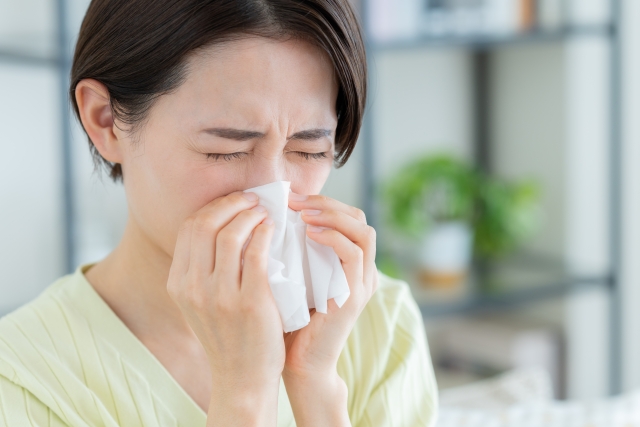Pollen Allergy You Should Know About Before Living in Japan
2024-06-10
Japanese Culture & Customs

Pollen allergy, caused by plant pollen, triggers allergic symptoms such as sneezing, runny nose, and itchy eyes.
Many foreigners develop pollen allergies after coming to Japan due to the abundance of Japanese cedar, a major cause of pollen allergy.
This article explains Japan’s pollen allergy, including the periods when pollen is dispersed and differences from pollen allergies in other countries.
Symptoms and Characteristics of Pollen Allergy in Japan
Pollen allergy is a condition where pollen from plants such as cedar, cypress, and grasses causes allergic reactions. Specific allergy symptoms may include:
- Sneezing, runny nose, nasal congestion (the three major nasal symptoms)
- Eye symptoms (itchiness, tears, redness, etc.)
- Itchy throat
- Itchy skin
- Diarrhea
- Feverish feeling
- Itchiness, numbness, or swelling of lips, tongue, mouth, and throat after eating fruits or raw vegetables (oral allergy syndrome)
In Japan, about 60 types of plants are reported to cause pollen allergies, with the main culprits being cedar, cypress, orchard grass, ragweed, birch, and Timothy grass.
In Western countries, pollen allergy is commonly referred to as “hay fever,” a term coined by British physician Dr. Bostock, who believed his symptoms were caused by contact with hay. In contrast, in Japan, cedar pollen accounts for about 70% of pollen allergy cases, and approximately 38.8% of the Japanese population is said to suffer from cedar pollen allergy. The current Kishida administration has even addressed pollen allergy as a “social issue.”
Severity of Pollen Allergy
The severity of pollen allergy is diagnosed by the frequency of sneezing, the number of times one blows their nose, and the amount of mouth breathing due to nasal congestion. Symptoms are categorized as “runny nose/sneezing type” if those symptoms dominate, “nasal congestion type” if nasal congestion is more severe, and “mixed type” if all three symptoms are equally strong.
Nasal symptoms affect breathing, impacting daily activities such as studying, working, and household chores, and can lead to poor sleep and reduced concentration. Eye symptoms, such as itchiness and a feeling of foreign objects, can worsen with increased pollen dispersion and lead to additional symptoms.
While severe pollen allergy is not life-threatening, oral allergy syndrome caused by pollen allergy can sometimes lead to anaphylactic reactions, requiring accurate diagnosis and treatment by a physician.
Differences from Pollen in Other Countries
According to the World Allergy Organization’s report for World Allergy Week 2016, the prevalence of pollen allergy has increased by an annual average of 0.3% over the past 15 years, reaching 22.1% globally.
Different plants grow in different regions, leading to varying causes of pollen allergies. In Europe, grasses are common allergens, ragweed in the Americas, and cypress in South Africa. Many foreigners who already have pollen allergies develop additional allergies to Japanese cedar upon arriving in Japan due to its endemic nature.
Regions with High Pollen Dispersion
About 70% of pollen allergy cases in Japan are caused by cedar pollen, which occupies 18% of Japan’s forests and 12% of its land. The Kanto and Tokai regions have a high concentration of cedar. In the Kansai region, both cedar and cypress have extensive plantation areas, so caution is needed for cypress as well. In Hokkaido, cedar and cypress are scarce, with birch being more prevalent.
Periods of High Pollen Dispersion
Knowing the pollen dispersion periods of plants that cause pollen allergies in Japan is crucial. Although many associate pollen allergies with spring, there are also autumn pollen allergies to be aware of.
Spring Pollen
- Cedar: Peaks in March, disperses until around May.
- Cypress: Peaks slightly later than cedar, in April, disperses until around June.
- Birch: Common in Tohoku and Hokkaido, peaks in May and June.
- Grasses: Disperses year-round in western Honshu, peaks in May and June in Kanto, and in June in Hokkaido.
Autumn Pollen
- Asteraceae (ragweed, mugwort) and Moraceae (hops): Disperses from August to October.
Precautions for Outdoor Activities During Pollen Dispersion Periods
Taking precautions when going out during pollen dispersion periods can help prevent or alleviate pollen allergy symptoms. Foreigners who do not yet have pollen allergies should also be mindful.
Pollen Information
In Japan, pollen forecasts are reported on TV, radio news, and the internet during pollen dispersion periods. Checking these forecasts before going out is advisable. Minimize outings unless necessary and take precautions if going out.
Times with High Pollen Dispersion
- Morning and Evening Pollen tends to disperse more in the morning and evening. As the temperature rises with the sunrise, pollen floats at eye and nose level, and as the temperature drops in the evening, pollen descends from the air. There are regional differences, so some areas may see increased dispersion during the warmest part of the day, around 1-3 PM.
- After Rain Pollen falls to the ground when it rains, reducing dispersion. However, after rain, the pollen on the ground is stirred up, doubling the amount of dispersing pollen.
Clothing to Avoid Pollen Exposure
Pollen adheres to the entire body. To prevent this, wear glasses or a mask for the eyes and nose, a scarf for the neck, and a hat for the hair. Smooth-surfaced outerwear is recommended to reduce pollen adherence. Recently, fabric softeners that prevent pollen adherence have also been available.
Returning Home
Brush off pollen before entering the house to prevent bringing it inside. Change clothes immediately after entering and wash your face to remove pollen.
Conclusion
This article explained pollen allergy in Japan. Due to the endemic nature of cedar in Japan, even those who have not previously suffered from pollen allergies or have allergies to different pollens abroad may develop new allergies. Check the dispersion areas and periods and take precautions when going out during these periods to prevent or alleviate pollen allergy symptoms.
